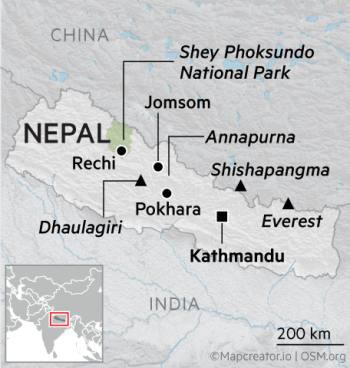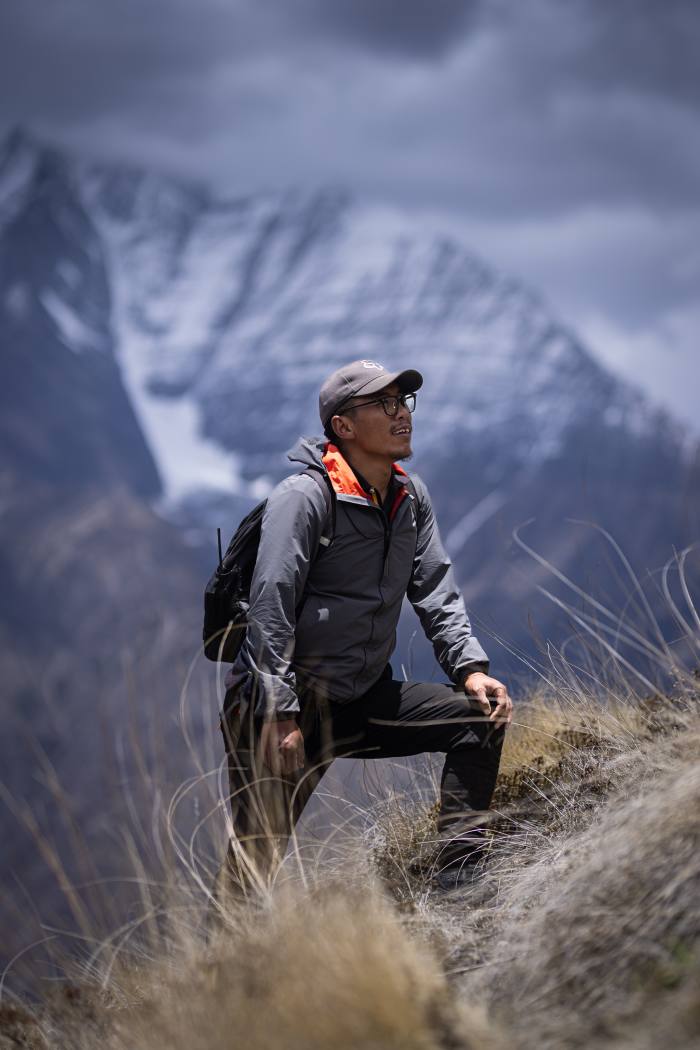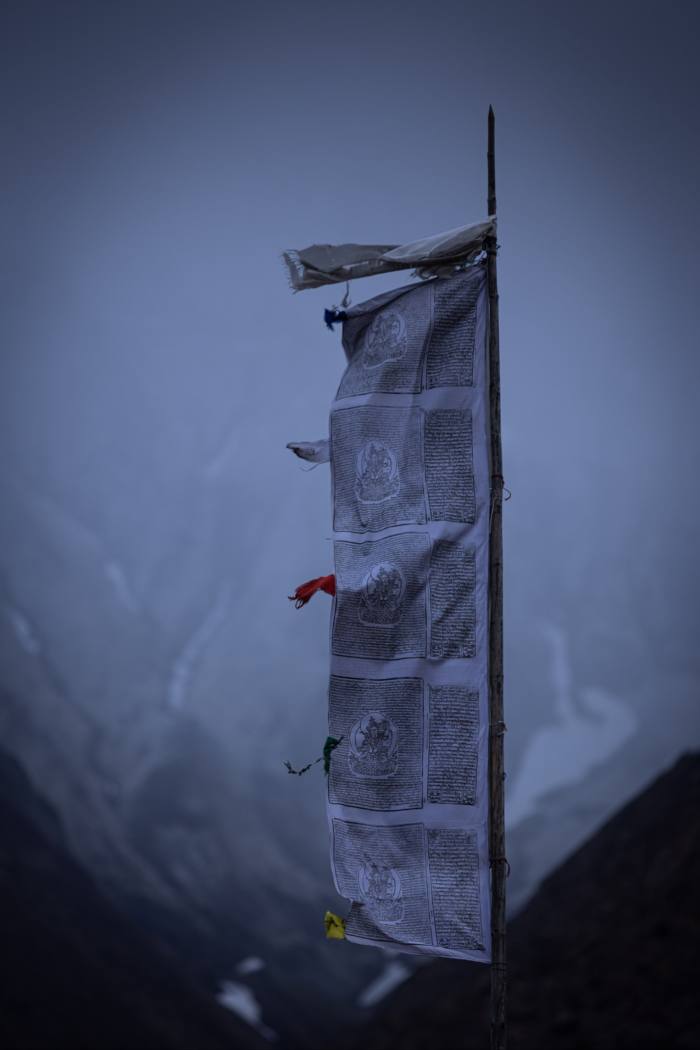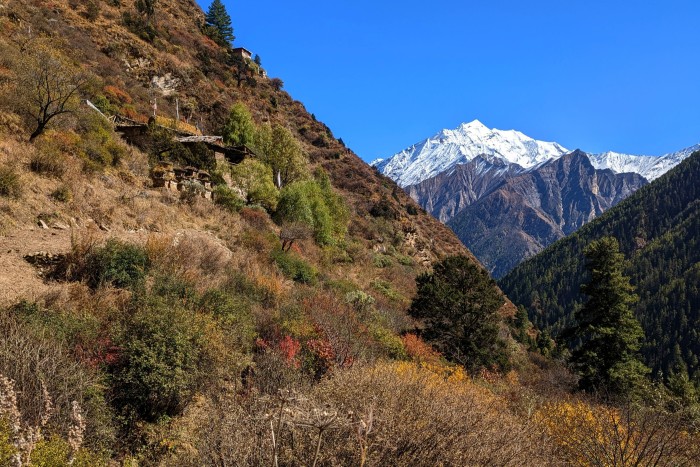In Dolpo, north-west Nepal, the river valleys are so steep they seem to close in on themselves, their sides sliding so tightly together that construction of a road to link the high-altitude villages is impossible. To live here is to live a life on foot, scrambling along tracks that are rocky and bound by precipitous drops, sometimes barely wide enough to walk single file, troubled by rockfall and seasonal washouts. It might take two days or more to trek to the nearest town for supplies, transporting fuel and grain home on your back, or by mule, pony or yak.
For this reason, Dolpo — a rugged, remote region made famous by Peter Matthiessen’s classic travel book The Snow Leopard (1978), in which he accompanied the ecologist George Schaller high into the Himalayas — has retained a richly traditional culture, one whose animist belief system holds the landscape to be densely populated by a pantheon of territorial and often wrathful gods.
The region has retained much of its wildlife too, much of it strange or unusual: red pandas, the Himalayan bharal (also known as the “blue sheep”), the small and goatlike goral and the famously elusive snow leopard — a creature that came to symbolise, to Matthiessen, the eternal quest for enlightenment. “If the snow leopard should manifest itself, then I am ready to see the snow leopard,” he wrote. It did not.
The snow leopard — a sleek, ghost-pale creature with luxuriant fur and an oversized, feather-duster tail — roams the stark mountainside above the tree line, slinking largely unseen between rock chutes and snow patches, springing from crag to boulder in pursuit of its serene and unsuspecting prey. It haunts the twilit hours, leaving only prints in the snow or the dust of a path that soon melt or fill or blow away entirely. One might live a lifetime in its territory and never catch a glimpse. Dolpo is one of the snow leopard’s last strongholds in the world. Today, there are an estimated 4,000-6,000 snow leopards surviving in the wild, sparsely distributed across the Central Asian and Himalayan mountains.

I had gone to Dolpo wishing, like Matthiessen, to see this beautiful monster for myself, and often following in the very footsteps of the Matthiessen expedition. I travelled as a guest of Nomadic Skies, an “ethical trekking company” set up by rural development experts Gavin Anderson and Jigme Lama that offers trips to remote parts of Nepal, Armenia and Uganda. Their Dolpo journey grew out of a research project that found visiting trekkers often had scarce interaction with mountain communities, and brought little economic benefit. Instead, their company aims to work in partnership with communities, using local staff and buying local supplies, in an area far from the well-known trekking routes.

It also prides itself on its slow travel philosophy, in contrast to the operators offering rapid circuits of Annapurna or helicopter-assisted treks to Everest base camp. In Dolpo, guests spend 13 nights trekking, from the tiny airport at Juphal to the village of Ringmo, beside the startling blue waters of Phoksundo Lake. They camp (the tents and luggage carried by mules) but stop to visit local people in their houses along the way. This allows plenty of time to explore the cultural and spiritual significance of the snow leopard in a community that at once reveres the creature for its ethereal nature and suffers dire economic consequences from its depredations upon their livestock.

Pusbah Garung is a quiet, peaceable woman who lives just off the main path in the sleepy village of Rechi. It is built like a labyrinth — a tangle of low drystone walls enclosing narrow lanes, corrals and kitchen gardens. Having lost her parents at a young age, Pusbah now supports her younger brother from a combination of weaving and goat-herding. She welcomes us to her home, a handsome stone building in the traditional Tibetan style — the ground floor is reserved for animals, and an upper floor, accessed via a raised wooden walkway, is where she sleeps, cooks and hosts.
Outside, as the sun dips behind the sides of the gorge, the temperature plunges. We sit cross-legged on mats, breath clouding the air, as Pusbah tends to the central stove. As she bends to feed small pieces of firewood into the flames, her face is lit with gold; on the stovetop, she brews tea from dried rhododendron flowers. The hard winters here, she says, render the high passes impenetrable for months at a time, but in spring she will move her animals up to the lush alpine meadows where they thrive on fresh new shoots and wildflowers. An Arcadian scene — but on the high ground, the animals are also at risk of attack.



Household members take it in turns to watch their flocks, but it’s hard to stay vigilant around the clock. And the snow leopard is so cunning, so hard to detect. Normally, she says, a village might lose one animal a month, but there are no guarantees. One year, a snow leopard wiped out 18 of her 45 goats, an unthinkable loss. They’d had a dog, to watch over the flock, but the leopards attacked it too and killed it.
The violence of the snow leopards comes in stark and shocking contrast to their usual watchful, silent manner. Once they have zeroed in on a vulnerable flock, they sometimes massacre far beyond what they could possibly consume. When they do eat, they regain their refinement, daintily picking away at a corpse over a period of days as they return, again and again, to the scene of their crime. It was long believed that the leopards did not devour their victims, as one might expect, but instead drank their blood, a misapprehension that only added to their eerie, unearthly reputation.
Pusbah is not a wealthy woman. Still, she says, she cannot begrudge them their kills. It is in their nature. I ask her if she felt angry, to lose all those animals, but she says no. What she felt had nothing to do with anger. Or perhaps, she corrects herself, it was a kind of anger. But what could you do with it? She could not catch the leopard, or kill it. In fact, if she sees one — padding soundless, wraithlike through the shadows — she finds herself mesmerised.
What she says is true. These creatures have a hypnotic element; an easy, almost balletic grace in their movements and a keen, dangerous focus. Low to the ground, soft-stepping, long-tails sweeping, the snow leopard has earned a special status in the minds of Himalayan peoples. But some resentment too, among those less tolerant than Pusbah. In the five years to 2022, more than 2,000 sheep and goats were attacked by snow leopards in the Shey-Phoksundo National Park, the 350,000 hectare conservation area in which Pusbah lives.


Three hours’ hike from Rechi, we arrive at Pungmo, where the landscape opens up to offer long views of snow-capped peaks. Here, the livestock is not goats or sheep but yaks, hundreds of them. In the hour before sunset, the female yaks begin to pour down off the hillside and into the narrow lanes between the houses. The female yaks are about the size of a pony, with a dark mop of hair, a hump at their shoulder, and curving, dangerous looking horns. We must dodge out of their way; they will not stop for pedestrians crossing. Though they look robust, they too can be vulnerable to snow leopards, especially the young calves at their feet.
Dawa Gyalpo, who lives in the village with his wife, baby and many members of his extended family, is the secretary of the local Livestock Insurance Scheme, a programme part-financed by the World Wildlife Fund to alleviate the financial pressure of living alongside apex predators — and thus guard against revenge attacks, which are rare but not unknown.
“Herders can insure a yak, a goat, a dzo [a yak-cow hybrid], anything. It must come with a photograph,” he explains. The yak herders pay small premiums, and if an insured animal is killed by a predator, they are offered financial relief. “Relief,” he stresses, “not full compensation.” There is also some relief from the state. “Before, the community found the paperwork very difficult, but we help them, and they can use the same paperwork to apply to both schemes.”
Conservation efforts find strong support locally. Pungmo, a very traditional village where religion is sewn into daily life, already abides by strict environmental controls. They worship according to Bon teachings, an ancient shamanic practice that has absorbed elements of Tibetan Buddhism, and holds all natural life in high regard. Its followers must refrain from killing or eating all animals, even those they breed.
Up the spine of the closest peak, and from small promontories all around, sunbleached prayer flags flutter on the wind, marking landmarks in a theological topography that cannot be appreciated by the naked eye. Or at least, not by my naked eyes.
Behind a nearby ridge, there is a holy river fed by the glaciers of a holy mountain. Every year, one man from every household must attend a spiritual retreat in a remote gompa, high above the village. In this way, “lay lamas” might be found in every house, overseeing (among other things) the community’s encounters with wild animals, which are said to be the livestock of the deities. Since his father died, Gyalpo has filled this role in his family.


The following day, he offers to lead us up to that sacred place, where an old lama lives year-round with his wife, far from disturbance. We zig and zag up a series of punishing switchbacks, until the trees thin out. Here, the hillside is dressed in dry grasses of amber and tan and orange, wildflowers of creamy white, fragrant herbs bleached yellow. In this glorious place, high in the heavens, close to the gleaming, snow-capped peaks, it feels quite probable it should be the domain of some possessive local god.
The lama’s house is stone-built, with a rough mortar and with dark, gnarled beams that protrude from the gable ends. The door and window frames are intricately carved, punched with woodworm. He agrees to an audience on the roof, and takes his place cross-legged on a yak-hair mat despite his advanced years — far more comfortably than me.
The snow leopard, he tells us, is not in itself a god. It has no special status; all animals are blessed. But sometimes a god might take the form of a snow leopard or command one to carry out his will. If a snow leopard has killed one of your flock, you are forced to question what you have done to displease the gods. Perhaps you have taken firewood without asking permission, or stone to build without first paying tribute. All such deals with nature must be sanctioned, not only by national park authorities but the gods themselves.


The lama has more general wisdom to impart. I sit in silence, wind ruffling my hair as he speaks. Be careful and kind and respectful, he tells us. Live with an open heart. Gratitude allows you to hold happiness in your hand. Most of all: you must be kind unto the animals. You may not kill them. Then, he promises, you will find that they will come to you. It is true. He gestures around himself in evidence. The heady scent of the garden, the rustling in the undergrowth, the griffons soaring on the thermals overhead.
Blue sheep come to him here, he tells us, on the 15th and 30th of every month. Musk deer visit him from the higher peaks. Snow leopards live here, all around in the house, in the caves that worm the stony hillside. It is as Matthiessen said: if we see a snow leopard, it will be because we are ready to see it.
When the lama has imparted all that he wishes, we return to the village. The dirt path is narrow, edged on one side by a rock face and on the other with a precipice. Gyalpo stops; before us, clearly etched in the dust, is the clear outline of a paw print. It is large, with four clear round toes. The central pad is wide and distinct, deeply creased at the base to create three soft cushions that gently merge into one. A few steps away: scat. Unmistakable.
A snow leopard was there, only hours before. Perhaps close by; watching us from some hideaway in the rocks. I didn’t see a snow leopard this trip, but I felt its presence keenly. Perhaps next time I will be ready to meet it.
Details
Cal Flyn was a guest of Nomadic Skies (nomadicskies.com), which offers an 18-night trip from £3,750 per person, including four in Kathmandu and 13 nights’ trekking in Dolpo, from Juphal to Lake Phoksundo. The next departures are in September and October this year



